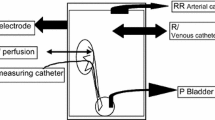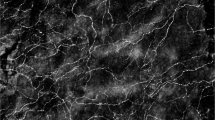Summary
Experimental uremia has been proposed as a model pathological state for improving the impregnation of nerve endings. It was induced in cats by ligation of the ureters. Interneuronal conections in the lumbar, thoracic, and cervical portions of the sympathetic chains were studied. A. comparison of the results with those obtained on normal animals showed that a considerably increased argentophilia had been induced, rendering the detailed structure more distinct.
Similar content being viewed by others
Literature Cited
V. P. Babmindra, Arkh. anat., 1958, No. 4, p. 85.
G. A. Ionkin and A. N. Leonov, Fiziol. zh. SSSR, No. 5, p. 425.
I. P. Korovin, The Pathological Anatomy of Uremia. Dissertation, St. Petersburg, 1897.
N. S. Kositsyn In book: Author's abstracts of the 13th Scientific Student Conference of Volgograd Medical Institute, Volgograd, 1954, p. 8.
Author information
Authors and Affiliations
Rights and permissions
About this article
Cite this article
Babmindra, V.P., Kositsyn, N.S. Experimental uremia as a model pathological condition for the study of the morphology of nerve endings. Bull Exp Biol Med 55, 233–234 (1964). https://doi.org/10.1007/BF00798840
Received:
Issue Date:
DOI: https://doi.org/10.1007/BF00798840




